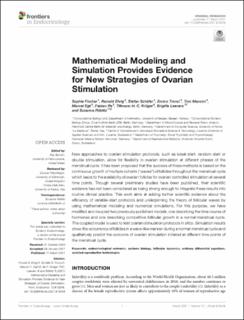Mathematical Modeling and Simulation Provides Evidence for New Strategies of Ovarian Stimulation
Fischer, Sophie; Ehrig, Rainald; Schäfer, Stefan; Tronci, Enrico; Mancini, Toni; Egli, Marcel; Ille, Fabian; Krüger, Tillmann H. C.; Leeners, Brigitte; Röblitz, Susanna
Journal article, Peer reviewed
Published version

Åpne
Permanent lenke
https://hdl.handle.net/11250/2766376Utgivelsesdato
2021Metadata
Vis full innførselSamlinger
- Department of Informatics [928]
- Registrations from Cristin [9791]
Originalversjon
Frontiers in Endocrinology. 2021, 12, 613048 https://doi.org/10.3389/fendo.2021.613048Sammendrag
New approaches to ovarian stimulation protocols, such as luteal start, random start or double stimulation, allow for flexibility in ovarian stimulation at different phases of the menstrual cycle. It has been proposed that the success of these methods is based on the continuous growth of multiple cohorts (“waves”) of follicles throughout the menstrual cycle which leads to the availability of ovarian follicles for ovarian controlled stimulation at several time points. Though several preliminary studies have been published, their scientific evidence has not been considered as being strong enough to integrate these results into routine clinical practice. This work aims at adding further scientific evidence about the efficiency of variable-start protocols and underpinning the theory of follicular waves by using mathematical modeling and numerical simulations. For this purpose, we have modified and coupled two previously published models, one describing the time course of hormones and one describing competitive follicular growth in a normal menstrual cycle. The coupled model is used to test ovarian stimulation protocols in silico. Simulation results show the occurrence of follicles in a wave-like manner during a normal menstrual cycle and qualitatively predict the outcome of ovarian stimulation initiated at different time points of the menstrual cycle.
